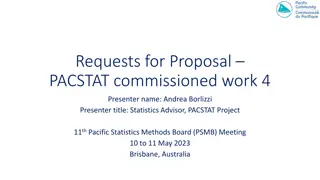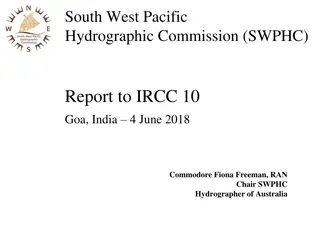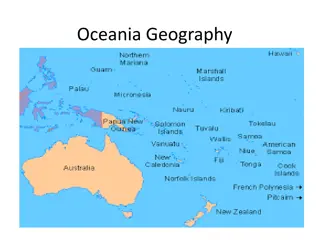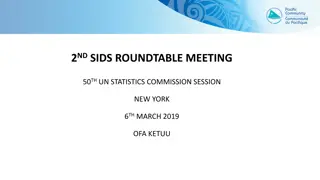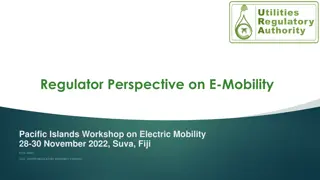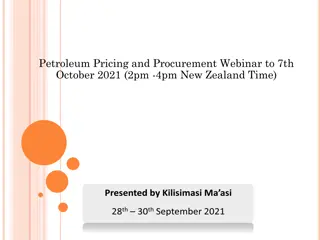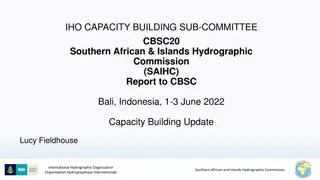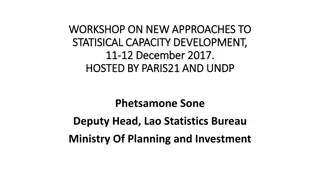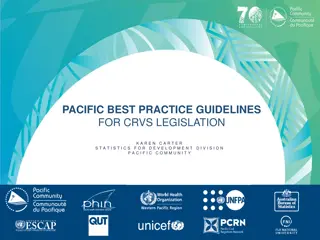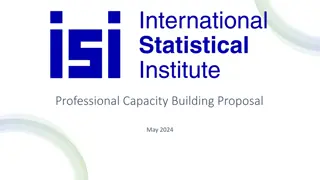Statistical Innovation and Capacity Building in the Pacific Islands (PACSTAT) Project Overview
PACSTAT aims to enhance welfare data quality and accessibility in Pacific Island Countries from July 2020 to June 2025. The project involves support to the Pacific Statistics Methods Board, institutional strengthening, and implementation support through alternative data collection methods. This initiative is part of the IDA regional program, focusing on enhancing statistical capabilities and data collection methodologies to improve welfare data comparability.
Download Presentation

Please find below an Image/Link to download the presentation.
The content on the website is provided AS IS for your information and personal use only. It may not be sold, licensed, or shared on other websites without obtaining consent from the author.If you encounter any issues during the download, it is possible that the publisher has removed the file from their server.
You are allowed to download the files provided on this website for personal or commercial use, subject to the condition that they are used lawfully. All files are the property of their respective owners.
The content on the website is provided AS IS for your information and personal use only. It may not be sold, licensed, or shared on other websites without obtaining consent from the author.
E N D
Presentation Transcript
Statistical Innovation and Capacity Building in the Pacific Islands (PACSTAT): Project introduction and the role of the Pacific Statistics Methods Board Presentation to the Pacific Statistics Methods Board 9 July 2020 Michael Sharp, Statistics for Development Division Allan Nicholls, Independent Consultant
Contents PACSTAT project summary PACSTAT results framework and monitoring The role of PSMB in PACSTAT The Project Operations Manual Discussion
PACSTAT project summary Development objective: To improve the quality of welfare data collection and accessibility to comparable welfare data in the Pacific Island Countries. Time: July 2020 to June 2025 (5-years). Components: i. Support to the Pacific Statistics Methods Board. ii. Institutional Strengthening and Implementation Support. iii. Alternative data collection methods. IDA regional programme: current sister projects in Tonga and Kiribati with a view to add more PICs in the next IDA funding round. Further information: https://projects.worldbank.org/en/projects- operations/project-detail/P168122
Component 1: Pacific Statistics Methods Board PSMB Technical Support & Administration (i) organise PSMB meetings; (ii) set the meeting agenda and invite appropriate international experts, as needed; (iii) coordinate the papers and reports to be reviewed at the PSMB meeting, (iv) identify priority topics for further review at subsequent PSMB meetings; and (v) summarize the meeting discussion into formal minutes and recommendations to be circulated to regional NSOs. As part of PSMB s function to promote academic rigor in its recommendations for standardizing data collection methods, it may commission additional research ( PSMB Commissioned Work ) to understand and tailor recommendations to the Pacific context. A budget of USD 125k has been allocated for PSMB Commissioned Work. Dissemination & Training Dissemination of best practice recommendations from the PSMB to NSOs with a strong emphasis on implementation as opposed to theory. Contracting of a Statistics Advisor for 4.5 years (60% of time allocated to this component).
Component 2: Institutional Strengthening and Implementation Support Expanding Technical Capacity of SPC-SDD Support to the Pacific Island Countries on welfare data collection, analysis and dissemination. (i) provide technical assistance and training on the implementation of the methodological recommendations generated by PSMB; (ii) harmonize key welfare indicators produced from HIES, including developing guidelines to standardize processes for harmonization and anonymization of such data; and (iii) develop and update a roster of consultants and academics to provide technical assistance to NSOs. Current Staff Support. Implementation Support. Contracting of a Welfare Economist for 4.5 years (60% of time allocated to this component). Contracting of a Harmonisation Advisor for 3 years (100% of time allocated to this component.
Component 3: Alternative data collection methods Innovations Technical Support PACSTAT will support experiments in alternative data collection methods, which could reduce the costs and complexity of collecting socioeconomic data in Pacific Island Countries, particularly by addressing the vast geography and sparse population constraints to traditional data collection. Funding for Innovation Experiments i) developing the experiments; (ii) implementing the experiments; (iii) preparing analytical reports, submitting them for PSMB review; and (iv) broadly disseminating the results. Contracting of a Statistics Advisor for 4.5 years (40% of time allocated to this component). Contracting of a Welfare Economist for 4.5 years (40% of time allocated to this component).
PACSTAT results and monitoring framework To improve the quality of welfare data collection Number of PSMB-commissioned guidance notes approved and disseminated (target of 10) Commission work to integrate international best practices into data collection and analysis, and make recommendations based on the findings. Number of experiment reports produced and submitted to PSMB (target of 4) Measure SPC-SDD performance in conducting the innovation experiments. To improve accessibility to comparable welfare data Number of regionally comparable indicators published on SPC platforms (target of 14) Measure SPC-SDD's performance in harmonizing historical microdata sets in the Pacific and producing comparable historical trends. Number of harmonized microdata sets published on SPC platforms (target of 5) Measure SPC-SDD's performance in harmonizing welfare indicators across the Pacific. Pacific Statistics Methods Board Number of PSMB meetings held during project lifetime (target of 10) Measure whether PSMB meetings continue to be held twice per year during the project lifetime. Number of PSMB commissioned work carried out using project financing (target of 5) Measure SPC-SDD's performance in carrying out PSMB commissioned research. Number of regional workshops conducted (target of 3) Measure SPC-SDD's performance in conducting workshops to disseminate PSMB findings.
PACSTAT results and monitoring framework Institutional strengthening and implementation support Number of SPC staff trained in welfare analysis (target of 5) Measure strengthened capacity of SPC-SDD in welfare economics. Number of HIES reports produced within 12 months of the completion of data collection (target of 6) Measure SPC-SDD's performance in supporting Pacific NSOs on their HIES fieldwork and data analysis. Number of analytical papers and briefs produced by SPC-SDD over the project lifetime (target of 10) Measure SPC-SDD's improved capacity to support Pacific NSOs in producing high quality analytical products. Number of gender indicators published on SPC platforms (target of 16) Based on UNSD minimum set of indicators. Number of consultations held around innovation experiments with beneficiary country NSOs and policymakers (target of 12) This indicator ensures that countries are adequately consulted in the process. Number of beneficiary country NSOs satisfied that their feedback has been reflected in the design of experiments (target of 8) The indicator tracks whether countries are satisfied with how their feedback was incorporated into experiment design. Data collection innovation experiments Number of data collection innovation proposals submitted through the annual work plan (target of 10) Measure SPC-SDD's performance in proposing innovation experiments.
The role of PSMB in PACSTAT PSMB commissions reviews of survey methodology aspects or innovative experiments on alternative data collection methods
The role of PSMB in PACSTAT October 2019 meeting of PSMB endorsed for the PACSTAT project to be a standing agenda item. Component 1: Functioning PSMB: ongoing engagement with PSMB and input to administrative matters. PSMB Commissioned Work: request submissions, evaluation and selection of research, guide TOR development, monitor progress, review/endorse findings, recommend adoption and communication strategies. Dissemination and training: advocate for statistical best practice and implementation. Component 2: Poverty assessment: advocate for statistical best practice in approaches to the measurement of poverty. Harmonisation / standardisation initiatives: advocate for statistical best practice in approaches to harmonisation / standardisation. Component 3: Innovative experiments: request submissions, evaluation and selection of experiment, guide TOR development, monitor progress, review/endorse findings, recommend adoption and communication strategies. Innovative experiments: advocate for statistical innovation and for the adoption and implementation of research recommendation. Support communication and dissemination of research findings.
The Project Operations Manual An essential early activity for the project is the development of a Project Operations Manual (POM), which will include: i. General information on the project and the POM. ii. Institutional arrangements for day to day execution of the Project. PSMB decision making process for commissioned work. Experiment activity cycle and the role of PSMB: identification; planning; implementation; monitoring; closure. iii. Details for submission of proposals for the innovation experiments on an annual basis through the annual work plan submission. i. ii. iii. The preparation and successive updates of the Procurement Plan and its implementation arrangements. iv. Implementation arrangements for the Environmental and Social Standards (ESS) instruments. PSMB in the Stakeholder Engagement Plan. i. v. Budgeting, disbursement, and financial management arrangements, including details regarding the Operating Costs, the Recurrent Technical Staff Costs and the Corporate Support Costs. vi. Project monitoring, reporting, evaluation and communication arrangements. Communication of PSMB recommendations and findings from PSMB commissioned work. i. vii. Detailed arrangements and procedures in relation to the experiments and sub-grants, including the eligibility criteria, procedures, guidelines and templates for the selection, approval, administration and supervision of an experiment and a beneficiary country, and the terms and conditions of a sub-grant and a Partnership Agreement. Eligibility criteria. Procedures, guidelines and templates for the selection, approval, administration and supervision of an experiment and beneficiary country. i. ii. viii. Other administrative, financial, technical and organizational arrangements and procedures as shall be necessary for the implementation of the project and the achievement of its development objectives; and ix. The preparation of a series of templates required for project implementation. Template for submission of proposals to PSMB. Assessment criteria for PSMB Commissioned Work and Innovative Experiments. i. ii.
Discussion PSMB s advice is sought on the following issues. i. Deciding on PSMB commissioned work The POM will need to specify The timetable for submitting proposals to the PSMB, having them evaluated and decisions made Guidelines / pro-forma for preparation of submissions Assessment criteria for PSMB approval of proposals Once a proposal is approved, what is the extent of involvement of PSMB in Development and approval of ToR Identification and hiring of consultants Monitoring progress Review / endorsement of outputs Recommending appropriate adoption strategies, including training Communication of results and recommendations to members
Discussion ii. Deciding on suitable Experiments The POM will need to specify The timetable for submitting proposals for experiments to the PSMB, having them evaluated and decisions made Guidelines / pro-forma for preparation of submissions Including proposals for partnership agreements with countries Assessment criteria for PSMB approval of experiments Once an experiment is approved, what is the extent of involvement of PSMB in Development and approval of ToR Identification and hiring of consultants Monitoring progress Review / endorsement of outputs Recommending appropriate adoption strategies, including training Communication of results and recommendations to members
Discussion iii. PSMB technical support and administration Is the status quo (in terms of SDD s technical and administrative role) acceptable, or is further support needed? Any comments or questions with respect to this component of the project? iv. Other Any other comments or questions or outstanding matters with respect to the project? v. Are we in a position to decide on the first: PSMB commissioned work? Innovative experiment (ref: session 2 high frequency monitoring)?




